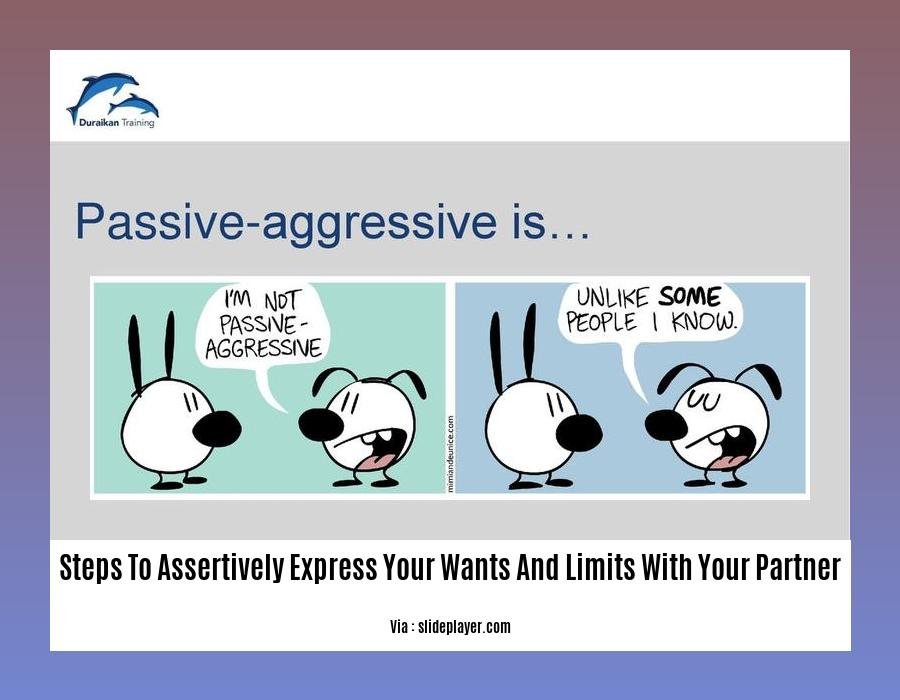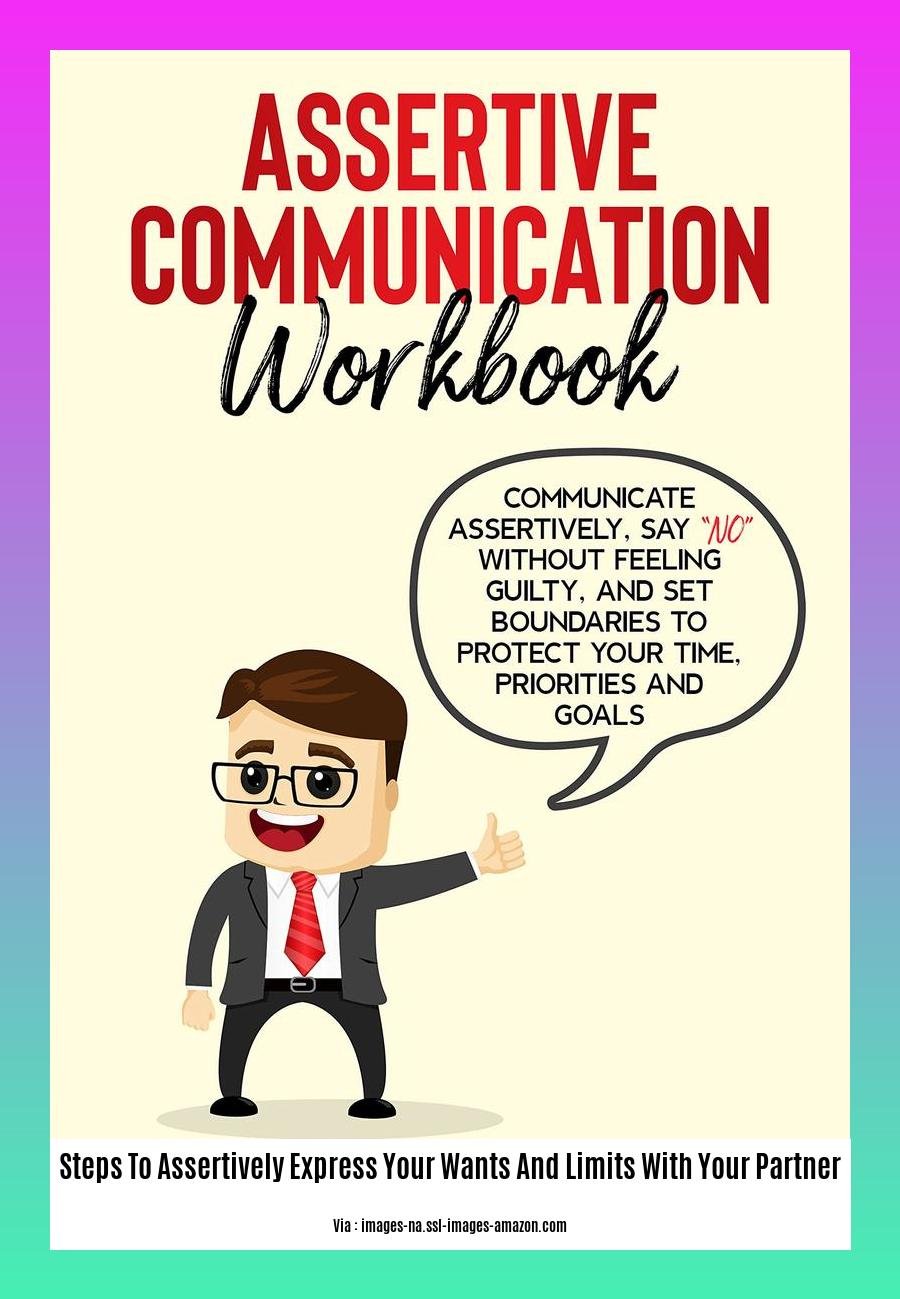Navigating the complexities of an intimate relationship often requires the ability to express your wants and limits assertively. By doing so, you can foster mutual respect, establish healthy boundaries, and create a more fulfilling connection with your partner. In this article, we will explore a series of steps to help you effectively communicate your needs and desires, empowering you to create a healthy and balanced relationship.
Key Takeaways:

- Understand your own needs and wants.
- Communicate your needs clearly and respectfully.
- Value both your own and your partner’s perspectives.
- Prepare what you want to say in advance.
- Listen actively to your partner’s response.
Steps to Assertively Express Your Wants and Limits with Your Partner
Being assertive in a relationship is key to expressing your needs, desires, and boundaries. Here’s a guide:
Step 1: Know Yourself
Identify your wants and limits. What do you need from the relationship? What behaviors make you uncomfortable?
Step 2: Choose Wisely
Pick a calm and quiet setting to avoid interruptions. Don’t have these conversations when you’re stressed or tired.
Step 3: Use “I” Statements
Start sentences with “I” to show ownership of your feelings. Avoid blaming your partner. For example, say “I feel overwhelmed when I have to handle all the household chores by myself” instead of “You never help me.”
Step 4: Clarity is Key
State your wants and limits clearly. Don’t be vague or passive-aggressive. Use specific language to convey your message.
Step 5: Positivity is Power
Focus on the positive side of your requests. Instead of saying “Don’t interrupt me,” say “I appreciate it when you let me finish speaking before you share your thoughts.”
Step 6: Active Listening
Let your partner share their perspective after you’ve expressed yours. Listen attentively to their thoughts and feelings.
Step 7: Compromise and Win
Assertiveness isn’t about getting your way all the time. Find solutions that work for both of you. Be willing to compromise.
Step 8: Practice Makes Perfect
Assertiveness takes practice. Start in situations where you’re comfortable. Gradually move to more challenging conversations.
-
Looking for ways to improve communication and set boundaries in your relationship? Check out our extensive guide to communicating needs and boundaries in a relationship.
-
Are you struggling to convey your needs and expectations clearly in your relationships? Our article on guide to clearly conveying your needs and expectations in relationships has everything you need to know.
-
Are you looking for healthy ways to discuss relationship boundaries and deal-breakers? Our article on healthy ways to discuss relationship boundaries and deal-breakers has got you covered.
Use “I” Statements
Articulating your needs clearly and confidently in a relationship is crucial for fostering mutual understanding and respect. One effective technique is using “I” statements. Here’s why they’re so powerful:
Key Takeaways:
- Express Ownership: “I” statements allow you to take ownership of your feelings and thoughts.
- Avoid Blame: Using “you” statements can be accusatory, leading to misunderstandings.
- Foster Respect: “I” statements prioritize your own experiences and boundaries.
- Facilitate Understanding: They help convey your needs in a non-confrontational manner.
Steps to Using “I” Statements:
- Identify Your Thoughts and Feelings: Before speaking, take time to reflect on your emotions and desires.
- Start with “I”: Begin your sentences with “I feel,” “I need,” or “I think.”
- Describe Your Experience: Clearly express how the situation affects you without blaming others.
- Use Specific Examples: Provide specific instances to illustrate your needs or concerns.
- Focus on the Positive: Emphasize the benefits of your request instead of dwelling on negatives.
Remember, assertiveness is not about aggression but about effectively communicating your wants and limits. By using “I” statements, you can foster a healthy dialogue, build understanding, and strengthen your relationship.
Citation:
Be clear and direct
Assertiveness can be challenging in any relationship, but it’s essential for healthy communication. When you’re clear and direct about what you want and need from your partner, you create a better foundation for mutual respect, trust, and understanding. Here’s how:
1. Avoid beating around the bush
Being vague or indirect can lead to confusion and misunderstandings. Instead, be clear and direct about your needs. For example, instead of saying “I need you to help more around the house,” you could say, “I’m feeling overwhelmed with the household chores. I would appreciate it if you could help me with the laundry and vacuuming.”
2. Use “I” statements
“I” statements allow you to express your feelings and needs without blaming or accusing your partner. For example, instead of saying “You never listen to me,” you could say, “I feel frustrated when I don’t feel heard.”
3. Be specific about what you want
Don’t just say you want your partner to be more helpful. Be specific about what you need them to do. For example, you could say, “I would like you to help me with the dishes every night after dinner.”
4. Be assertive, not aggressive
Assertiveness is about expressing your needs and desires in a respectful way. It’s not about being aggressive or demanding. When you’re assertive, you’re more likely to get what you want without damaging your relationship.
Key Takeaways:
- Be clear and direct about your needs and desires.
- Use “I” statements to express your feelings and needs without blaming or accusing your partner.
- Be specific about what you want from your partner.
- Be assertive, not aggressive, when expressing your needs and desires.
Most Relevant URL Source:
- How To Be Assertive – 14 Tips For Clear & Direct Communication
Use positive language
Expressing your wants and limits in a relationship can be tricky, but using positive language can make all the difference. When you focus on the positive aspects of your requests, you’re more likely to get what you want while also preserving the relationship.
Here are a few tips for using positive language when expressing your wants and limits:
- Instead of saying, “You never help me with the dishes,” try saying, “I’d really appreciate it if you could help me with the dishes more often.”
- Instead of saying, “You’re always interrupting me,” try saying, “I feel more respected when you let me finish speaking before you share your thoughts.”
- Instead of saying, “You’re so messy,” try saying, “I’d love it if we could work together to keep our home a little tidier.”
By using positive language, you can express your needs without sounding accusatory or demanding. This will make it more likely that your partner will be receptive to your requests.
Key Takeaways:
- Focus on the positive aspects of your requests.
- Use phrases like “I’d appreciate it if…” or “I feel more respected when…”
- Avoid using accusatory or demanding language.
Most Relevant URL Source:
- Assertive Communication: Definition, Examples, & Techniques:











